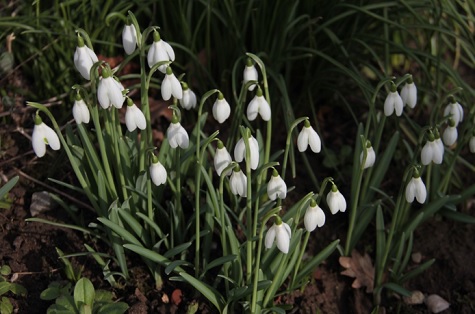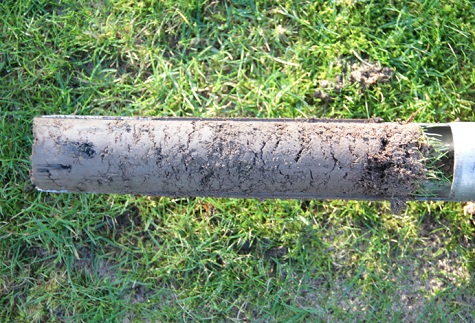This week I thought it would be appropriate to start thinking about your spring renovations.
Only last week I was out on site in Church Stretton taking some soil samples to establish what work may be needed to be done on their tennis, croquet and bowling greens.
Taking a few core samples enables you to physically identity any issues that may be lurking below the playing surface.

Establishing the depth of any thatch, compaction, root breaks and anaerobic conditions will help you identify the right course of action to take in the coming weeks. Generally a spring renovation on a natural fine turf surface is centred around some aeration work, light scarification, overseeding and feeding.

Winter games pitches will need a more intense course of action to repair the damage done by winter play. The level of work will be determined by the current state of the pitch. In the main, most grassroots or club level rugby and football pitches will need to be aerated (decompacted) using either a Verti-Drain solid tine spiker or linear disc aerator. Ideally they should also be scarified to clean out any surface dead fibre, topdressed, fertilised and overseeded.
There’s no doubt many grass roots winter pitches will have suffered from the very wet winter we have just had, especially those pitches that have specific drainage schemes installed.

It would also be advisable to have some soil samples taken and sent for analysis testing for soil nutrient status and perhaps PSD (Particle Size Distribution) to help classify the soil type you have.
The procedure of determining the proportion of mineral particles in each of these classes is called particle size analysis or mechanical analysis of the soil. In soil analysis, the proportion of gravel and larger particles is determined by first grinding the soil to disaggregate it and then passing it through a 2 mm sieve.
What remains in the sieve is weighed and its proportion calculated as a percentage of the whole soil sample. The proportion of the coarse, medium and fine sand are likewise determined by sieving, thus separating them from the clay and silt fractions of the soil. The latter cannot be separated from one another by sieving. Instead they are separated by a process known as sedimentation, which is based upon the fact that larger particles fall more quickly through water than smaller ones.
Thus, if a suspension is made up of clay and silt in water, the silt will settle out more quickly than the clay and by measuring the speed at which the suspension as a whole settles out, it is possible to determine the distribution of particle sizes. When you have the percentages of clay silt and sand you are then able to classify your soil type.

Once you have all this information, you are then able to determine the best course of action and plan and get quotes for your spring renovations.
In recent years we have seen an array of soil conditioning equipment on hand to speed up the way we can renovate grass surfaces. Richard Campey of Campey Turfcare has over the years been instrumental in bringing to market a number of revolutionary sports turf renovation machines that sports turf contractors are now using to speed up and improve renovation techniques. Namely the Koro Fraise mower that can remove up to 25mm of vegetation by literally planing the top off. The Koro recycling dresser meanwhile, is a heavy-duty aerator and root-zone recycler that is able to aerate the underlying soil vertically and horizontally, removing the soil from the root-zone and re-distributing it across the playing surface.

The Recycling Dresser reduces the amount of new top-dressing required, therefore saving labour and material costs and promoting sustainable maintenance. Three different working widths are available in the new range.
Your choice of seed mixtures will be dependent on the sport you are playing and the price you want to pay. In general terms you should be looking to invest in a good quality sportsturf rye grass seed mixture. We have an excellent choice of suppliers and seed companies who over the years have developed top quality grass seed. Listed below are four leading suppliers of perennial rye grass seed for sports pitches.
- Limagrain’s MM60 Grass Seed is suitable for the renovation and repair of winter sports pitches, racecourses and areas where fast germination and quick establishment are priorities.
- A20 (Premier Ryesport) for winter sports pitches, the choice of many top groundsmen across the UK.
- Johnsons J Rescue 100 is also suitable for winter/spring emergency overseeding on winter sports pitches, golf tees, polo fields and racecourses.
- Rigby Taylor’s R14 100% Perrenial Ryegrass Blend Grass Seed 20Kg is also a very popular seed used by many groundsmen

Prices range from £75-£150 per bag, which is not cheap especially when you need between 8-12 bags per pitch - giving you an average cost of around £1200 to seed a whole pitch. Not wanting to waste any seed, it would pay to ensure you use a seed drill to plant the seed into the pitch and not just broadcast it on the surface.
The Vredo Disc Seeder and other similar machines are used for overseeding or sowing sports pitches and large grass areas. The disc system places seed under the surface, improving the rate of germination. The slits are then closed by the rear roller, leaving little disturbance to the surface.
One of the other key factors that determines the success of germination will be the fact that the pitch is kept watered. We would hope that nature can usually take care of this with some timely periods of rain soon after renovations have been completed. However, no doubt some parts of the country will experience dry spells, thus needing you to irrigate the pitch using sprinklers.

Many top end sports clubs and schools have in recent years invested in either, a pop-up sprinkler system or acquired a self-traveling sprinkler system to water their pitches.
However, I must stress that once you have invested and completed your spring renovations it is vitally important you follow up with a robust maintenance programme, carrying out regular cutting, aeration, verticutting, feeding and watering to produce a vigorous and healthy sward.
And finally, it would be well advised to get all your machinery all serviced and prepped for the start of the new mowing season.